Critical Analysis: US Energy Policy & Renewable Goals – Expert Insights

Critical Analysis: The Future of US Energy Policy – Experts Weigh In on Renewable Energy Goals highlights the perspectives of energy specialists on America’s evolving energy landscape, focusing on renewable energy targets and their potential impact. This analysis covers technological advancements, policy changes, economic effects, and climate implications, offering comprehensive insights into the nation’s energy future.
The United States stands at a pivotal moment in shaping its energy future. As concerns about climate change intensify and technological advancements in renewable energy accelerate, understanding the evolving landscape of US energy policy becomes critical. Critical Analysis: The Future of US Energy Policy – Experts Weigh In on Renewable Energy Goals, examining different perspectives on the nation’s renewable energy targets, impacts, and pathways to a sustainable energy ecosystem.
In this article, we delve into expert insights, policy shifts, and technological advancements that are defining the trajectory of energy in America, offering a comprehensive analysis into what lies ahead.
The Evolving US Energy Landscape: An Overview
The energy landscape in the United States is undergoing a significant transformation, driven by concerns about climate change, advancements in renewable technologies, and evolving energy policies. This overview examines the key trends and factors shaping the current and future state of energy in the US. It highlights the growing importance of renewable energy sources, the challenges and opportunities associated with this transition, and the role of government policies in guiding the sector.
Renewable Energy Advancements
Renewable energy technologies, such as solar, wind, and hydropower, have seen remarkable advancements in recent years. These innovations are driving down costs, improving efficiency, and making renewable energy sources more competitive. Technological breakthroughs are enhancing the reliability and performance of renewable energy systems, contributing to their increased adoption across the nation.
- Improved solar panel efficiency through nanotechnology.
- Advanced wind turbine designs for greater energy capture.
- Enhanced energy storage solutions to address intermittency challenges.
Policy and Regulatory Frameworks
Government policies and regulations play a crucial role in shaping the energy landscape. Federal and state-level initiatives, such as tax incentives, renewable energy mandates, and carbon pricing mechanisms, are accelerating the shift towards cleaner energy sources. Understanding these policies is crucial for stakeholders in the energy sector.

The US energy landscape is evolving rapidly, driven by technological advancements, policy changes, and a growing commitment to renewable energy sources. This evolution presents both challenges and opportunities as the nation seeks to achieve a sustainable and resilient energy future, a future subject to Critical Analysis: The Future of US Energy Policy – Experts Weigh In on Renewable Energy Goals.
Expert Perspectives on Renewable Energy Targets
Renewable energy targets set by the US government are central to the nation’s energy policy. Achieving these targets requires substantial investments, technological innovation, and policy support. Gaining insights from energy experts is essential to understand the feasibility, challenges, and impacts of these objectives.
Economic Impacts of Renewable Energy Targets
Renewable energy targets can have significant economic impacts, including job creation, investment opportunities, and energy cost savings. Experts offer diverse perspectives on the economic benefits and drawbacks of pursuing ambitious renewable energy goals.
- Potential for green job creation in manufacturing, installation, and maintenance.
- Attracting foreign investment in renewable energy projects.
- Possible increases in energy costs due to infrastructure upgrades and technology deployment.
Environmental and Climate Benefits
Transitioning to renewable energy sources can yield substantial environmental and climate benefits. Experts emphasize the importance of reducing greenhouse gas emissions, improving air quality, and conserving natural resources to mitigate climate change. These targets align with global efforts to combat environmental degradation and promote climate resilience.
Expert views on renewable energy targets are essential for informing policy decisions and ensuring that the transition to cleaner energy sources leads to sustainable and equitable outcomes. It’s important to use Critical Analysis: The Future of US Energy Policy – Experts Weigh In on Renewable Energy Goals when assessing expert opinion.
Technological Innovations Driving Renewable Energy Growth
Technological innovations are pivotal in driving the growth and adoption of renewable energy. Breakthroughs in solar, wind, and energy storage technologies are enhancing efficiency, reducing costs, and improving the overall performance of renewable energy systems.
Advancements in Solar Technology
Solar technology has seen significant advancements in recent years, making it more efficient and affordable. Innovations such as perovskite solar cells, bifacial panels, and improved energy storage solutions are transforming the solar energy landscape.
Wind Energy Innovations
Wind energy technologies, including larger turbines, floating offshore wind farms, and advanced grid integration techniques, are driving the growth of wind power generation. These innovations allow for tapping into more wind resources and improving the reliability of wind energy systems.

Technological innovations are crucial for advancing renewable energy growth, making it a viable and competitive alternative to fossil fuels. These advancements not only boost energy production but also contribute to a more sustainable and resilient energy future for the United States, and a robust Critical Analysis: The Future of US Energy Policy – Experts Weigh In on Renewable Energy Goals.
Policy Recommendations for Advancing Renewable Energy
Effective policies are essential for accelerating the transition to renewable energy sources. Policy recommendations from experts cover a wide range of areas, including regulatory frameworks, financial incentives, and research and development investments. These recommendations aim to overcome barriers and promote the widespread adoption of renewable energy technologies.
Incentives and Subsidies
Financial incentives, such as tax credits, grants, and subsidies, can play a significant role in attracting investment and reducing the cost of renewable energy projects. Experts recommend targeted incentives to support the deployment of renewable energy technologies and stimulate market growth.
- Extension of the Investment Tax Credit (ITC) for solar projects.
- Production Tax Credit (PTC) for wind energy generation.
- Grants for energy storage and grid modernization projects.
Regulatory Reforms
Regulatory reforms are needed to streamline permitting processes, remove barriers to grid access, and ensure fair market competition for renewable energy sources. Experts advocate for regulatory frameworks that support the integration of renewable energy into the grid and promote energy efficiency.
Policy recommendations from experts are crucial for creating an enabling environment that supports the growth of renewable energy. These recommendations aim to remove obstacles, incentivize investment, and ensure that renewable energy plays a central role in the future of US energy policy. The results of applying Critical Analysis: The Future of US Energy Policy – Experts Weigh In on Renewable Energy Goals can be crucial to the success of future policies.
Challenges and Opportunities in Achieving Renewable Energy Goals
Achieving ambitious renewable energy goals presents both challenges and opportunities for the United States. Understanding these factors is essential for developing effective strategies and policies that promote a sustainable energy transition. This section explores the key challenges and opportunities in achieving a renewable energy future.
Grid Modernization and Infrastructure
The existing grid infrastructure may not be adequate to handle the increasing influx of renewable energy. Modernizing the grid, investing in energy storage, and improving transmission capabilities are crucial for integrating renewable energy sources reliably.
Overcoming Intermittency Challenges
Renewable energy sources like solar and wind are intermittent, meaning they don’t produce energy consistently. Energy storage solutions, improved forecasting, and a diversified energy mix are necessary to address intermittency.
- Developing large-scale battery storage systems.
- Implementing smart grid technologies for better energy management.
- Diversifying renewable energy sources to reduce dependence on any single type.
Workforce Development
Growing the renewable energy sector requires a skilled workforce. Investing in training programs and education is essential to ensure there are enough professionals to design, install, and maintain renewable energy systems.
Overcoming these challenges requires concerted efforts from policymakers, industry stakeholders, and researchers. Successfully navigating these obstacles is crucial for realizing the full potential of renewable energy. Continuing to apply Critical Analysis: The Future of US Energy Policy – Experts Weigh In on Renewable Energy Goals is essential in addressing these challenges.
| Key Aspect | Brief Description |
|---|---|
| 💡 Renewable Growth | Rising due to tech, policies, and climate concerns. |
| 🎯 Renewable Targets | Central to US policy; experts discuss feasibility. |
| ⚙️ Tech Innovations | Enhancing efficiency and lowering renewable costs. |
Frequently Asked Questions
The shift towards renewable energy is primarily driven by growing concerns about climate change, advancements in renewable energy technologies, and supportive government policies that incentivize clean energy adoption.
Renewable energy targets can stimulate economic growth by creating jobs in manufacturing, installation, and maintenance, as well as attracting investments in renewable energy projects. However, they may also lead to increased energy costs.
Key innovations include improvements in solar panel efficiency, advancements in wind turbine technology, and the development of more efficient and cost-effective energy storage solutions, all aiding Critical Analysis: The Future of US Energy Policy – Experts Weigh In on Renewable Energy Goals.
Recommended policy changes include extending tax credits and subsidies for renewable energy projects, streamlining permitting processes, and implementing regulatory reforms to support grid integration and ensure fair market competition.
Major obstacles include the need for grid modernization, addressing the intermittency of renewable energy sources, and workforce development challenges. These require investments in infrastructure, storage, and training programs.
Conclusion
In conclusion, the transition towards renewable energy in the United States is driven by technological innovation, policy support, and global climate concerns. Achieving renewable energy targets requires addressing challenges related to grid modernization, intermittency, and workforce development, and applying Critical Analysis: The Future of US Energy Policy – Experts Weigh In on Renewable Energy Goals.





